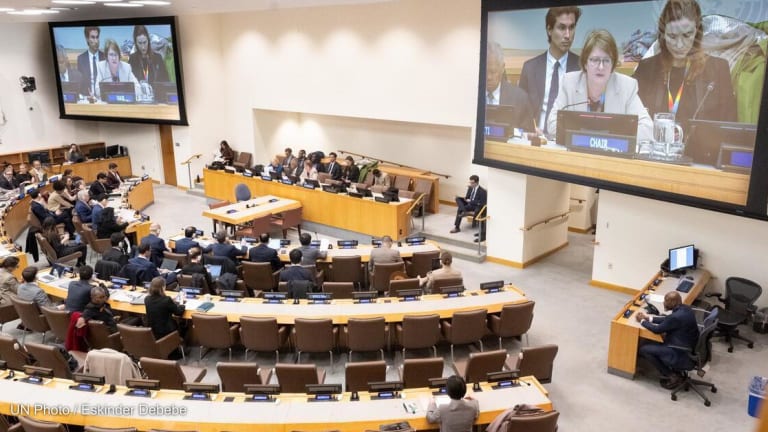Pushing for a more grass-roots approach to build peace
Despite substantial development progress in recent decades, conflict and the absence of peace has rendered a portion of the global population worse off. Harriet Lamb, CEO at International Alert, tells Devex how a grass-roots approach to peace building and conflict resolution can help change that.
If indicators including literacy, health and life expectancy are used to measure development progress over the past couple of decades, few would argue against the assertion that people now are generally better off than they were 30 years ago. Prior to the adoption of the Sustainable Development Goals in New York in September, the United Nations published a report on the results of the Millennium Development Goals — the SDGs' predecessor — and the findings were cause for optimism. In 2015, the number of people living in extreme poverty decreased to 836 million from 1.9 billion at the turn of the millennium; the number of out-of-school youth declined to 57 million from 100 million over the same period; and average life expectancy increased by six years since 1990, according to the World Health Organization. And this is on top of per capita income growth across the globe — the global gross domestic product has risen sevenfold over the past half-century, notwithstanding the issue of an uneven distribution of that wealth. But from the perspective of conflict resolution and peace building, are we better off now? Harriet Lamb, CEO of the London-based group International Alert, shared with Devex that while successes in other aspects of global development is evident, the issues of peace building and conflict resolution have been in a “constant tug-of-war” of progress and crisis. “The way the sector has been trying to deal with the issue of peace building has definitely evolved, with many approaches and strategies being implemented,” she told Devex in an exclusive interview during a visit to Manila, Philippines. “But there's a still a long way to go in trying to sustainably reduce instances of conflict and establish long-lasting peace in the world,” she added. While a number of countries have been attempting to forge long-lasting peace agreements through continued dialogue and policy discussions — including the ongoing peace talks in the Philippines and progress on deals in Myanmar and Colombia — elsewhere in the world, violence and conflict have continued to escalate, with protracted crises in the Middle East and Africa posing a grave risk to civilian lives and associated human development progress. The number of deaths caused as a direct result of violence, for instance, exceeded the 100,000 mark in 2014 — the highest total since the 1994 Rwandan genocide — according to data from the University of Uppsala in Sweden. This is on top of the largest refugee crisis since World War II which UNHCR estimates could exceed the 60 million forced displacement threshold, according to their 2015 projections. “The Syrian war and the subsequent refugee crisis this past couple of years have really affected the progress that we've made in peace-building activities,” Lamb said, adding that advocacy to promote and build peace is “historically underinvested.” The International Alert chief, who previously worked for Fairtrade International and the Fairtrade Foundation prior to taking up her current position, said that part of reason peace and conflict issues have been somewhat sidelined as government development priorities is the lack of proper understanding of what constitutes peace building and conflict resolution. The London-based group defines peace as the situation “when people are able to resolve their conflicts without violence and can work together to improve the quality of their lives.” Another reason is the fact peace building and conflict resolution discussions and strategies, for both good and bad reasons, keep changing and evolving. Lamb shared that this sometimes give the feeling that the community is doing a catch up on how to solve the various conflict issues that arise globally instead of being one step forward — something that a grass-roots approach can help resolve. “There is always the challenge of making people understand what peace-building activities are, or what conflict resolution strategies can be, as some discussion points can be considered very conceptual,” Lamb said. “Conflict situations are also rooted in different causes, [so] a blanket approach is very difficult to pursue.” In the group's 2014 annual report, the emphasis on a grassroots approach to peacebuilding and conflict resolution is strong — from community empowerment and constructive dialogue, to private sector participation: “Peace cannot be imposed from the top or imported from outside. It is built from the ground up.” Francisco Lara Jr., country manager at International Alert Philippines, echoed this sentiment, citing the example of a local program that literally maps conflict situations and hot spots in a certain coverage area through inclusive reporting by community representatives, which then allow his group to know exactly where to focus their work on to have more impact. The program, called the Bangsamoro Conflict Monitoring System, highlights the importance of grass-roots data and input from communities which are under conflict situation in designing sustainable and inclusive peace-building mechanisms and programs. This approach is evident in 42 countries around the world where the group has a strong presence — from the homes in Pakistan, the kitchens in Turkey and Armenia, the classrooms in Rwanda, and even in the waiting rooms of health care centers in Lebanon. Lara Jr. shared that peace and the absence of conflict and violence can start from the smallest unit of communities and from the smallest gestures that every individual makes. Lamb also highlighted the group’s “pathways to peace” that focus not just on simmering tensions and escalating violence but also on the “opportunities for peace” that development stakeholders can undertake. The “pathway” consists of seven focus areas that could directly affect peace building efforts, to include a focus on relations within and between communities, crime, violence and instability, natural resource management, climate change impact, gender issues, citizenship and the state, and economic development. The International Alert chief concluded the need for stakeholders to understand that violence and conflict happen for a multitude of reasons, which requires a careful understanding and attention from those involved in the industry to make sure that the issues are addressed sustainably, while ensuring that the people affected in the conflict situation remains at the center of discussions and resolution. After all, said Lamb, “peace doesn't fall out of heaven.” Read more international development news online, and subscribe to The Development Newswire to receive the latest from the world’s leading donors and decision-makers — emailed to you FREE every business day.
If indicators including literacy, health and life expectancy are used to measure development progress over the past couple of decades, few would argue against the assertion that people now are generally better off than they were 30 years ago.
Prior to the adoption of the Sustainable Development Goals in New York in September, the United Nations published a report on the results of the Millennium Development Goals — the SDGs' predecessor — and the findings were cause for optimism.
In 2015, the number of people living in extreme poverty decreased to 836 million from 1.9 billion at the turn of the millennium; the number of out-of-school youth declined to 57 million from 100 million over the same period; and average life expectancy increased by six years since 1990, according to the World Health Organization.
This article is free to read - just register or sign in
Access news, newsletters, events and more.
Join usSign inPrinting articles to share with others is a breach of our terms and conditions and copyright policy. Please use the sharing options on the left side of the article. Devex Pro members may share up to 10 articles per month using the Pro share tool ( ).
Lean Alfred Santos is a former Devex development reporter focusing on the development community in Asia-Pacific, including major players such as the Asian Development Bank and the Asian Infrastructure Investment Bank. He previously covered Philippine and international business and economic news, sports and politics.








